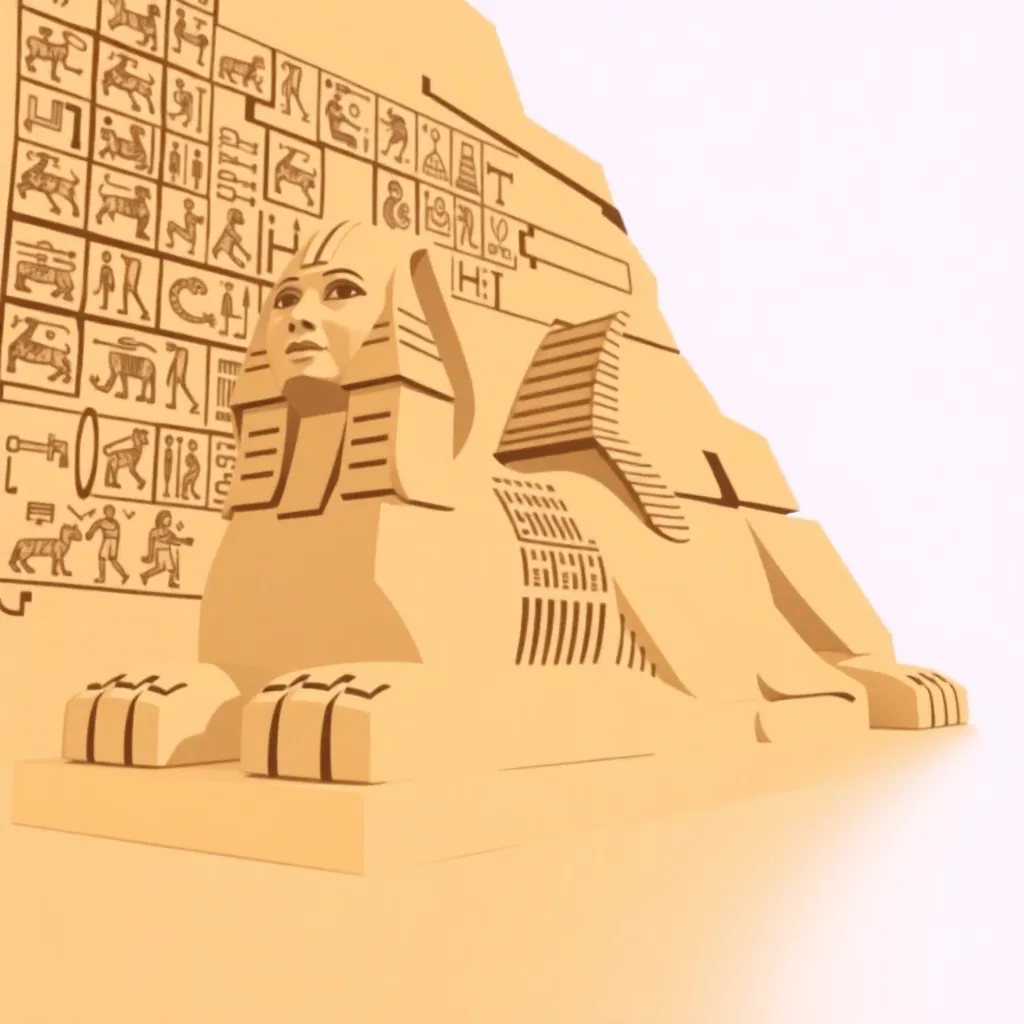The Sphinx in Ancient Egyptian Hieroglyphs
I. Introduction
The Great Sphinx of Giza stands as one of the most recognizable symbols of Ancient Egypt, an enduring cultural icon that embodies the mysteries of the past. Carved from limestone, this monumental statue with the body of a lion and the head of a pharaoh has fascinated historians, archaeologists, and tourists alike for centuries. Its presence not only speaks to the architectural prowess of the Ancient Egyptians but also to their rich mythology and belief systems.
Hieroglyphs, the intricate writing system of Ancient Egypt, played a pivotal role in documenting the civilization’s history, culture, and religious beliefs. This article aims to explore the significance of the Sphinx through the lens of hieroglyphs, examining its historical context, representation, symbolism, and the impact it has had on both ancient and modern cultures.
II. Historical Context of the Sphinx
The Great Sphinx of Giza was built during the reign of Pharaoh Khafre (c. 2558–2532 BCE) and is part of a larger complex that includes the famous pyramids. The Sphinx measures approximately 73 meters in length and 20 meters in height, making it one of the largest and oldest statues in the world.
- Origins and construction: The Sphinx’s construction aligns with the peak of the Old Kingdom period, where monumental architecture was a means of demonstrating pharaonic power.
- Role in mythology: In Ancient Egyptian mythology, the Sphinx is often associated with the sun god Ra, symbolizing strength and protection.
- Connection to Pharaohs: The Sphinx was believed to serve as a guardian to the pharaohs, protecting them in the afterlife.
III. The Language of Hieroglyphs
Egyptian hieroglyphics, a complex writing system using pictorial symbols, were employed to convey ideas, record history, and express religious beliefs. This unique form of writing consists of over 700 symbols, each representing sounds, objects, or concepts.
- Explanation of Egyptian hieroglyphics: Hieroglyphs can be read in multiple directions, and their meanings often depend on context.
- Conveying complex ideas: Hieroglyphs allowed scribes to convey intricate narratives and religious texts, often inscribed on temple walls and papyrus scrolls.
- Significance of symbols: Each symbol had deeper meanings, connecting the written word to the spiritual world.
IV. The Representation of the Sphinx in Hieroglyphs
The Sphinx is not just a physical structure but also a subject of numerous hieroglyphic inscriptions and representations throughout Egyptian history.
- Specific hieroglyphs associated with the Sphinx: The Sphinx is often depicted alongside hieroglyphs representing royalty and divine protection.
- Depictions in ancient texts: The Sphinx appears in various inscriptions, including those found in tombs and temples, often symbolizing the ruler’s divine right.
- Symbolism in hieroglyphic art: Artistic representations of the Sphinx often highlight its role as a protector and its association with the sun.
V. The Sphinx’s Symbolism in Ancient Egyptian Beliefs
In Ancient Egyptian beliefs, the Sphinx held profound symbolic meanings that went beyond its physical form.
- Guardian figure: The Sphinx was seen as a guardian, protecting sacred spaces and the afterlife.
- Relationship with solar deities: Often associated with the sun, the Sphinx represented the connection between the pharaohs and the divine.
- Representation of power and protection: The Sphinx symbolized the might of the pharaoh and the protection of the Egyptian state.
VI. Archaeological Discoveries Related to the Sphinx
The ongoing archaeological work at the Giza Plateau has yielded significant discoveries related to the Sphinx, enhancing our understanding of its historical and cultural context.
- Major excavations: Excavations have revealed numerous artifacts, including tools and offerings, that provide insight into the Sphinx’s construction and its role in society.
- Inscriptions and artifacts: Inscriptions found near the Sphinx have shed light on its significance and the rituals associated with it.
- New discoveries: Recent findings continue to challenge previous theories, offering fresh interpretations of the Sphinx in the context of hieroglyphs and Egyptian beliefs.
VII. Modern Interpretations and Cultural Impact
The Sphinx’s influence extends far beyond its ancient context, permeating modern literature, art, and culture.
- Contemporary literature and art: The Sphinx has inspired countless works, symbolizing mystery and enigma in various artistic expressions.
- Influence on modern culture: Elements of Egyptian symbolism, including the Sphinx, continue to appear in popular media, fashion, and architecture.
- Ongoing research: Modern archaeologists and historians are continually revisiting the Sphinx, uncovering new theories about its purpose and significance.
VIII. Conclusion
In summary, the Great Sphinx of Giza stands as a monumental testament to the ingenuity of Ancient Egyptian civilization. Its representation in hieroglyphs highlights the intertwined nature of art, language, and belief in Ancient Egypt.
The Sphinx’s legacy endures, not only as a guardian of the past but also as a symbol of the mystery and power that continues to captivate the world today. Understanding the Sphinx through the lens of hieroglyphs allows us to appreciate the complexity of Ancient Egyptian culture and its lasting impact on humanity.




